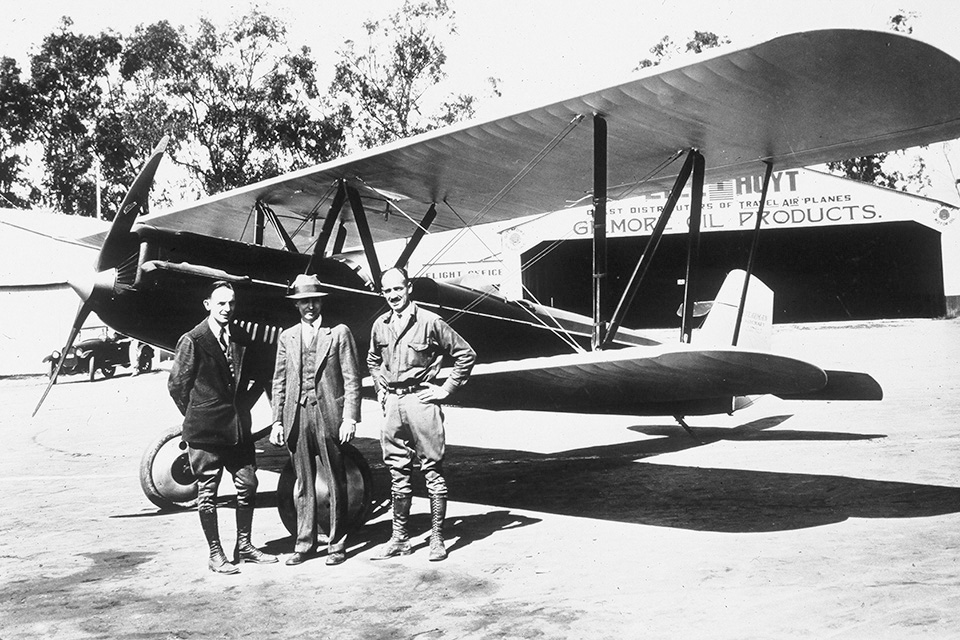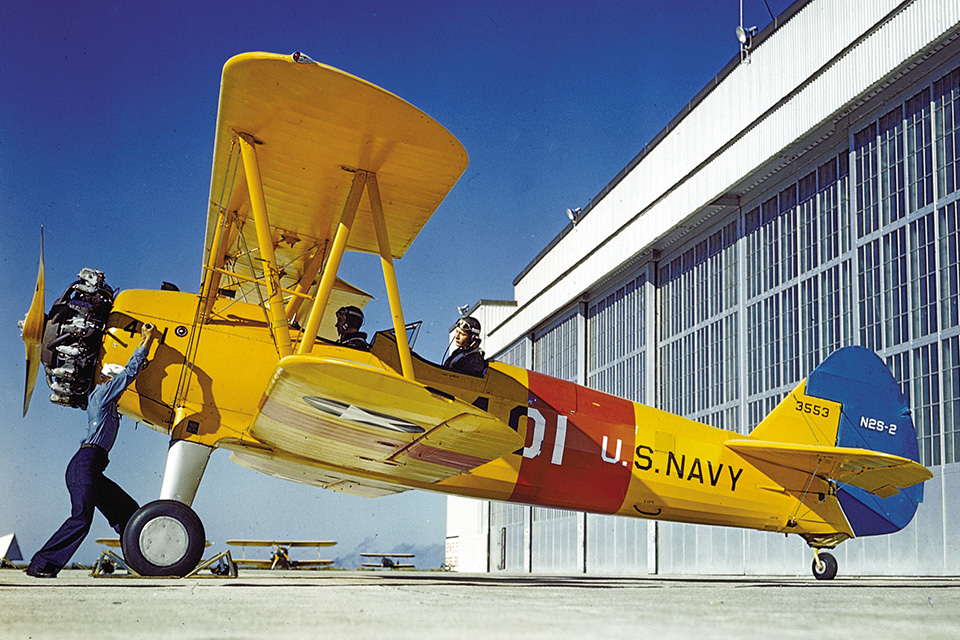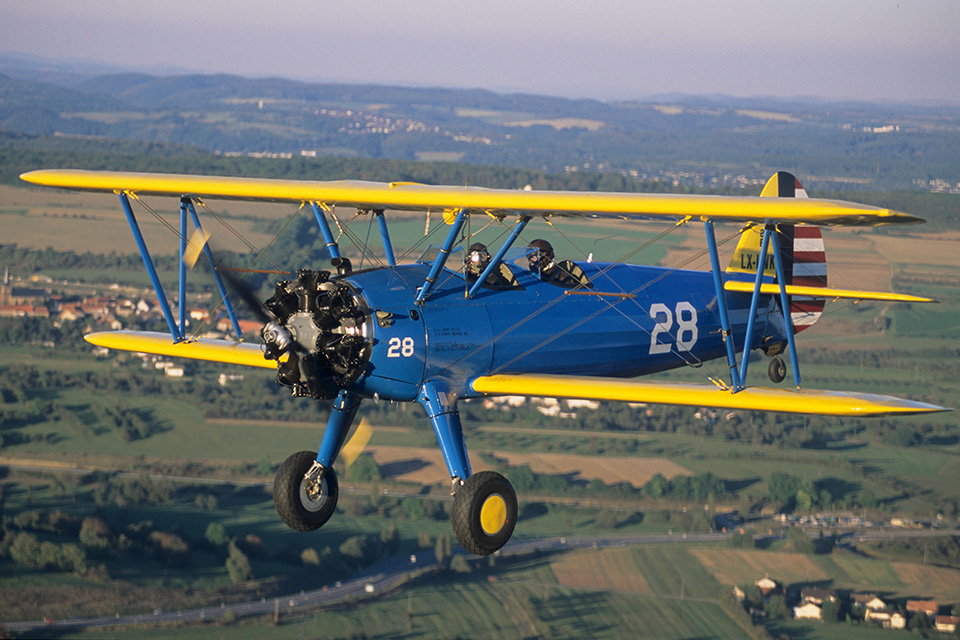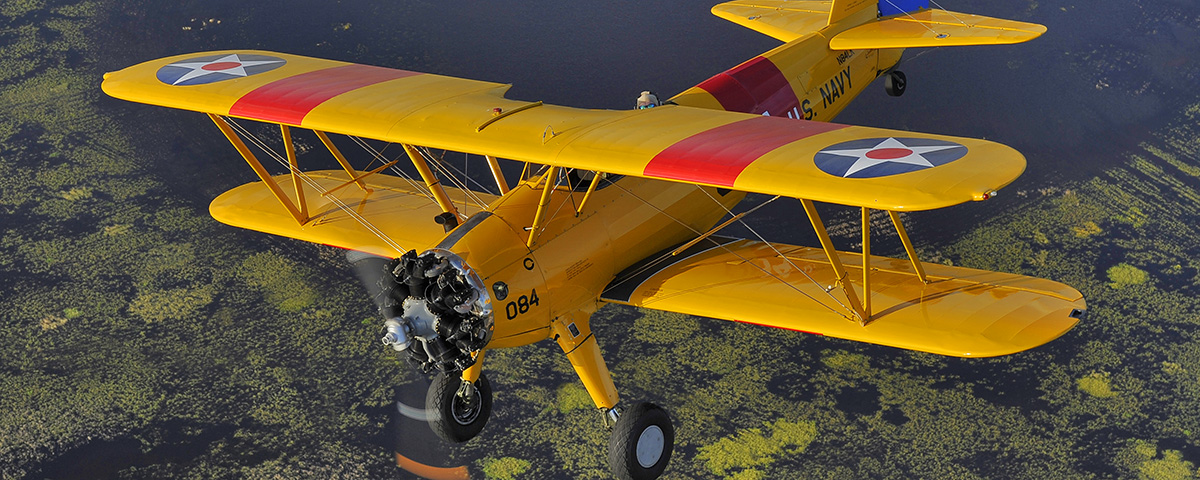More than eight decades after its introduction, the classic Stearman continues to thrill pilots looking for open-cockpit adventure.
The Boeing Model 75 “Stearman” was the most prolific primary training aircraft of World War II and the United States’ most produced biplane.
Today it is the most recognizable biplane still flying, often appearing at airshows and fly-ins, with many tucked away in hangars all across the country. The rumble of its radial engine and its classic shape never fail to turn heads skyward. Pilots and non-pilots alike love the Stearman.
“The Stearman was extremely well built, strong and flew very well and was fairly easy to fly,” says Stearman owner and pilot Tom Lowe, co-founder of the National Stearman Fly-In. “But it was a challenge to fly well. A new [WWII cadet] pilot who could master the Stearman could move on up into more advanced aircraft easily.”
Although aviation pioneer Lloyd Carlton Stearman did not design the airplane, at least not directly, he did contribute to the classic trainer. Stearman had learned to fly Curtiss N-9 floatplanes in the U.S. Navy during World War I, and went to work for the E.M. Laird Airplane Company in Wichita, Kan., after the war. When the company reorganized as the Swallow Aircraft Company, Stearman became chief engineer and Walter Beech was the test pilot. In 1925 Stearman and Beech, along with Clyde Cessna, formed the Travel Air Company. The following year Stearman went to Venice, Calif., and with members of the Lyle-Hoyt Aircraft Company, a Travel Air distributor, formed the Stearman Aircraft Company. In October 1927, Stearman Aircraft relocated to Wichita, and in 1929, along with a dozen other aviation companies, became part of United Aircraft and Transportation Corporation (UATC), which was owned by William Boeing.

Stearman built airplanes for civilian use and mail transport, and they earned a reputation as being durable and dependable. With the stock market collapse and onset of the Great Depression in October 1929, Stearman looked to the military market, specifically to airman training, in order to stay in business. He developed the Stearman Model 6, eventually building 10 of the two-seat biplane trainers. By the end of 1930, the U.S. Army Air Corps was looking to replace its Consolidated primary trainers, and Stearman submitted the Model 6, which the Air Corps designated XPT-912. The airplane fell short of the Army specifications, so Stearman made changes and subsequently was awarded a contract for four service test trainers, designated YPT-9s. Although the YPT-9 was not ordered into production, Stearman sold a half-dozen Model 6s in the civilian market under the name Cloudboy.
Stearman left his company in December 1930, though he kept his seat on the board of directors until June 1931. In 1933 Stearman chief engineer Mac Short, along with engineers Howard Zipp and Jack Clark, designed the Stearman Model 70, an open-cockpit biplane trainer based on Lloyd Stearman’s Model 6. As with the Model 6, this new airplane was designed with the hope of winning a military contract, built on speculation and without any government funds.
The Model 70’s wingtips and rudder were more rounded than the Model 6’s, and the horizontal stabilizer was also modified. Rather than being moveable for pitch trim, the stabilizer was fixed and trim tabs were added to the elevators. The lines of the fuselage were smoothed and rounded. Unlike most biplanes of the day, the Model 70 had single-strut oleo landing gear. The Army had complained that the YPT-9 was actually too easy take off and land—the military wanted a more challenging airplane for cadets. With its tall, narrow landing gear, the Model 70 fit the bill. By modifying an existing airframe, the company designed and built the biplane in just 60 days.
The sole Model 70 first took to the air on January 1, 1934, with test pilot David “Deed” Levy at the controls. Evaluated by both the Army and the Navy, the airplane exhibited stall characteristics that were considered too tame for cadet training, plus it could not meet the Navy spin and recovery requirement: a one-turn recovery after a 10-turn spin. Therefore, stall strips, or more accurately spin strips—small triangular strips of wood on the wing leading edge—were added. These strips would be used on all subsequent Stearman primary trainers.
The Navy was the first to order the new trainer, initially purchasing 41 examples in 1934 and later adding another 20. The Navy designation for the Model 73 production version was NS-1. Since the Navy had excess Wright J-5 Whirlwind engines in its inventory, they powered the NS-1 rather than the Model 70’s Lycoming R-680. Stearman Aircraft was now in the business of supplying the military.
In another 1934 event that impacted Stearman, government anti-trust legislation broke up UATC, separating aircraft manufacture from airline service. Stearman Aircraft was now a wholly owned subsidiary of Boeing Aircraft and remained in Wichita.
The Model 75 was an improved Model 73 with a lengthened fuselage and larger tail, slightly modified landing gear and a NACA 2213 airfoil. This became the Army PT-13.
In 1938 Boeing bought Stearman Aircraft, making it a Boeing division. The majority of the Model 75 trainers were built during the ensuing years, and therefore the data plates carry the Boeing name rather than Stearman’s, though the airplane is usually referred to as a Stearman. Enthusiasts and current Stearman pilots often simply refer to the biplane as a PT-17, regardless of its original military designation.
Three different radial engines were used in the Model 75 trainers: the Continental R-670, Lycoming R-680 and Jacobs R-755. Each engine/airframe combination had its own Army and/or Navy designation. Engine selection depended primarily upon availability.
The PT-27 was intended for Canadian use and underwent a number of modifications, including the addition of an electrical system, landing lights and a cockpit canopies. Piper Aircraft Company of Lock Haven, Pa., was contracted to supply the canopies. About 300 trainers were sent to Canada, but the Navy intercepted the canopies for their own use at cold-weather training bases. The Canadian planes were soon shipped back to the States.
In addition to its formal military numerical designations, the Model 75 was called the “Kaydet” by the Army and “Midshipman” by the Navy, though those terms were seldom used. Army pilots generally referred to it as a Stearman. Naval aviators nicknamed their yellow-painted version the “Yellow Peril,” a moniker that originated with the yellow N3N biplane trainer built by the Naval Aircraft Factory in Philadelphia.

Jerry Yellin, who flew P-51 Mustangs in the Pacific during World War II, received his primary training in the Stearman at Thunderbird Field near Phoenix, Ariz. “I remember the first girl I made love with and the first time I soloed a plane,” he recalled. “Soloing in that back seat was a thrill. The Stearman was a splendid experience. They couldn’t have built a better plane.” When asked about that narrow landing gear and crosswind landings, he said, “Crosswinds are always a challenge. And there’s a lot of surface area on the Stearman. You have to be on your toes.” Yellin has attended the National Stearman Fly-In in Galesburg, Ill., for the past three years, and still flies.
George Farnsworth, another WWII veteran combat pilot, owns and flies a Stearman, and still finds it a joy to fly. He served in North Africa and Italy during the war, flying P-38 Lightnings. Enlisting in 1942, he left his hometown of Chicago to go to Arcadia, Fla., for primary flight training in Stearmans. “I was excited,” he said of the experience. “I’d never been in an airplane before. So I was excited at learning to fly. The Stearman was a forgiving airplane. It responded as they [instructors] said it would. It was easy to fly. It maybe was too forgiving. Like most, I soloed in 6½ hours.”
On February 16, 1945, a special ceremony marked the final Model 75 to roll out the doors at Boeing Wichita, a PT-13D. After the war, Boeing bought it back from the Army.
David Wright, who served in the Navy from 1943 until 1946, went to work at Boeing Wichita in 1951. He recalled seeing that last PT-13D at the plant. “[Boeing test pilot] ‘Tex’ [Johnston] flew dignitaries, well-known names in the political world, and one or two Hollywood actors,” he said. “It was quite a treat to go up with ol’ Tex. After Tex parked the Kaydet, it was up to the transportation crew to take it to Plant 1. One kid had taken some flying lessons and the crew knew this. They put him in the cockpit. Either by the [tug] driver’s own intention or if he was prompted, he got it going fast enough that the plane’s tail came up. If they’d been seen, probably the whole crew would have been dismissed.”
That PT-13D is now at the National Museum of the U.S. Air Force in Dayton, Ohio, having been donated by Boeing in September 1958. It is claimed to be Kaydet number 10,346, though the actual number of fully assembled Model 75s produced is 8,585. The larger figure includes unassembled spares.
Rather than being scrapped like so many of its WWII contemporaries, the Model 75 was granted a new lease on life. Due to its rugged steel-tube fuselage and docile flight characteristics, it became a much-sought-after airplane for civil use, especially for agricultural work. Though it was a rough-and-tumble existence that claimed many planes, agricultural flying in the end saved many Stearmans. “The ag industry can never be credited too highly for saving the Stearman,” said Tom Lowe. “Without the ag industry, not many would still be available today. My own plane was a mosquito fogger.” Restorer and Stearman pilot Mike Porter noted, “Probably 99 percent of the Stearmans flying today were crop dusters.”
Converting Stearmans for agricultural use involved extensive modifications. The chemical tank was normally located in the front cockpit, with some tanks extending to the instrument panel of the rear cockpit, which necessitated relocating the engine and flight instruments. Wingtips were sometimes modified—some squared off, some incorporating end plates, some with Hoerner tips. Other changes included canopies over the cockpit, different tailwheel assemblies and enlarged rudders. The stock engine was often replaced by a 450-hp Pratt & Whitney R-985 Wasp Jr. from a Vultee BT-13.
In a bit of irony, Lloyd Stearman formed the Inland Aviation Company in Los Banos, Calif., to convert surplus Stearmans to crop dusters.
The rugged Stearman also became a favorite of airshow performers. As a primary trainer, it was approved for all the maneuvers a cadet would need to learn. Painted in bright colors, with a smoke system added, the big biplane presented quite a spectacle while doings loops and rolls. Add a wing-walker and the act was complete.
Eventually purpose-built agricultural aircraft relieved Stearmans of their duty flying low over fields, dodging power lines and trees. And aerobatic aircraft that can perform maneuvers undreamed of years ago now wow airshow crowds, though Stearmans still grab attention with their smoke, sound and classic shape.
The Stearman should have been left abandoned or scrapped after all its years of service, but the warbird restoration movement occurred at just the right time to grant the airplane yet another lease on life. The restoration movement began in earnest as the Stearman was being phased out of the ag business in the late 1960s.
Porter, who flight instructs in Stearmans as well as restores them, owns a plane that served at Avenger Field in Sweetwater, Texas, as a primary trainer for the Women Airforce Service Pilots (WASP). His Stearman reflects the latest trend in restoration. Prior to that movement, the focus was on flying and maintaining the airplanes and adding whatever paint or modifications suited the individual. Now the emphasis is on historical accuracy, or “ultra-accuracy,” to coin Porter’s term.

Porter said corrosion from farm chemicals is one of the biggest problems that needs to be remedied when bringing a Stearman back to life. The planes were abused and flown hard, and when they could no longer pass inspection they were often just parked. “They are beautifully built airplanes,” he said. “They were beautifully engineered. The metal on them is anodized. The steel-tube frame was filled with linseed oil and drained. It can’t rust from the inside.”
Porter said the appeal to modern pilots “is its history, its military history. It also was the last biplane to be mass produced. It is extremely parts-available. It is challenging and enjoyable to fly. It has modern controls, and the seats and rudder pedals are adjustable.”
Porter’s Stearman students are typically new owners of the airplane. Their flying skills are often rusty, and the Stearman can be a handful for them. “There’s a 46-gallon gas tank in the center of the upper wing, 10 feet up,” explained Porter. “It makes for a high center of gravity. Ailerons are only on the bottom wing, and in a crosswind the upper wing is like a sail.”
As a surplus aircraft after WWII, a Stearman could be had for a few hundred dollars. Today a stock flying Stearman goes for $60,000 to $85,000, a good restoration for $100,000 to $150,000 and one equipped with a 450-hp engine can go for as much as $200,000. Today it is estimated there are about 1,500 Stearmans still flying.
So why is the Boeing 75 so loved? Those who pilot it appreciate its history, its flying characteristics and the romance of open-cockpit flight. Its rugged steel-tube construction has kept it alive for all these years, and no doubt when it is 100 years old it will still be gracing the skies. As Jerry Yellin said, “They couldn’t have built a better airplane.”
Early-aviation enthusiast W.M. Tarrant is the author of East to Meet the Enemy: A Novel of World War One Aerial Combat. He lives in Galesburg, Ill., home of the Stearman Fly-In. Further reading: Stearman Aircraft: A Detailed History, by Edward H. Phillips; and Wings of Stearman: The Story of Lloyd Stearman and the Classic Stearman Biplanes, by Peter M. Bowers.
This feature appeared in the September 2017 issue of Aviation History magazine. Subscribe today!

